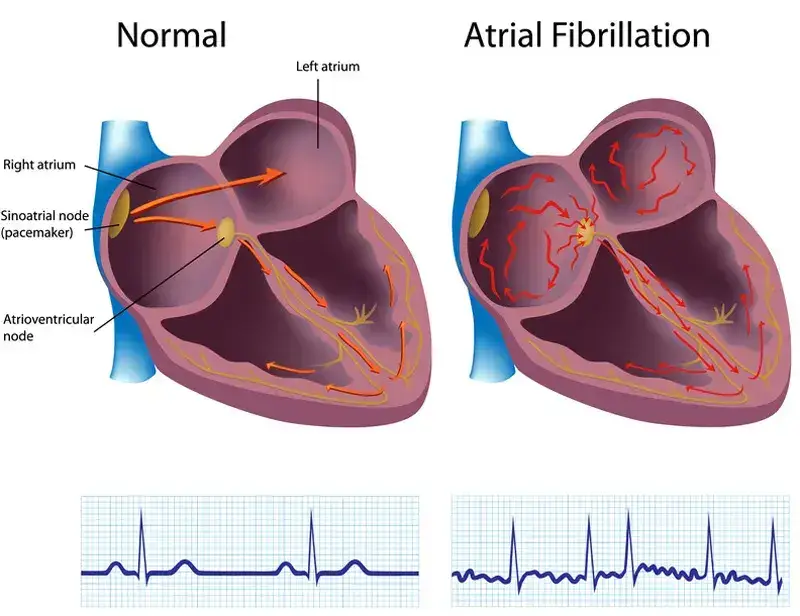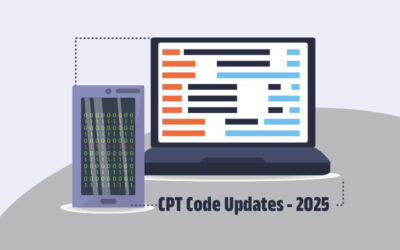Atrial Fibrillation (also called AFib or AF) is a heart condition that causes an irregular and often rapid heart rate that can increase your risk of stroke, blood clots, heart failure and other heart-related complications. Regarded as one of the most commonly diagnosed cardiac rhythm disturbances, AFib begins in the upper chambers of your heart (the atria) and causes those to quiver (fibrillate), instead of beating normally. The condition causes the heart’s two upper chambers (the atria) to beat irregularly with the two lower chambers (the ventricles) of the heart. This can lead to formation of blood clots in the heart that may circulate to other organs and lead to blocked blood flow (ischemia). Treatment for this cardiac condition may include medications and other interventions that attempt to alter the heart’s electrical system. Documenting this condition requires correct recording of all the prominent symptoms, diagnosis and treatment procedures provided. Medical coding outsourcing is an option worth considering as this can help cardiologists to ensure timely and accurate claim submission for optimal reimbursement for the medical services offered.
Atrial fibrillation may be – occasional, persistent, long-standing persistent and permanent. As per reports from the American Heart Association (AHA) about 2.7 million Americans live with atrial fibrillation, the most common heart rhythm disorder. It is estimated that about 15-20 percent of people who have strokes have this heart arrhythmia. Abnormalities or any damage to the heart’s structure are the most common causes of AFib. Other potential causes include – high blood pressure, coronary artery disease, heart attacks, congenital heart defects, overactive thyroid gland, lung diseases, previous heart surgery, viral infections and long term exposure to stimulants such as medications, caffeine, tobacco or alcohol.
What Are the Symptoms of Atrial Fibrillation?
Generally, some people with AFib experience no specific symptoms and are quite unaware of this condition until it is discovered during a detailed physical examination. Common signs and symptoms include –
- Palpitations (sensations of a racing, irregular heartbeat or a flip-flopping in your chest)
- Weakness
- Reduced ability to exercise
- Fatigue and lightheadedness
- Dizziness
- Confusion
- Shortness of breath
- Chest pain
- An irregular pulse
The potential factors that may increase your risk of developing atrial fibrillation include age, family history, obesity, heart disease, high blood pressure, alcohol consumption and other chronic conditions.
How Is AFib Diagnosed and Documented?
In order to diagnose this cardiac rhythm disorder, your physician may conduct a detailed review of your previous medical history and evaluate the signs and symptoms. A thorough physical examination will be conducted where in the physician may order several diagnostic imaging tests such as Electrocardiogram (ECG), Echocardiogram, Chest X-ray, Event recorder, Holter monitor, stress test and other blood tests to accurately diagnose the degree of heart abnormality.
Generally, the treatment for AFib aim to reset the rhythm or control the heart rate, prevent blood clots and reduce the risk of strokes. The treatment methods for atrial fibrillation may mainly depend on how long the person suffered from the condition, its underlying causes and type and severity of symptoms. Normally, a combination of medications and other surgical procedures will be offered to set the heart rate and rhythm to normal.
Treatment procedures include – Electrical cardioversion and other surgical procedures such as Catheter ablation, Atrioventricular (AV) node ablation, surgical maze procedure and Left atrial appendage closure. Medications include – anti-arrhythmics such as Dofetilide (Tikosyn), Flecainide, Propafenone (Rythmol), Amiodarone (Cordarone, Pacerone), Sotalol (Betapace, Sorine) and Anticoagulants such as Warfarin (Coumadin, Jantoven) and Dabigatran (Pradaxa).
Cardiology medical coding involves the use of specific ICD-10 codes and CPT codes to document different cardiology conditions, including atrial fibrillation (AFib). The following medical codes are used –
ICD-10 Codes to Indicate Diagnosis of AFib
I48 – Atrial fibrillation and flutter
- I48.0 – Paroxysmal atrial fibrillation
- I48.1 – Persistent atrial fibrillation
- I48.2 – Chronic atrial fibrillation
- I48.3 – Typical atrial flutter
- I48.4 – A typical atrial flutter
I48.9 – Unspecified atrial fibrillation and atrial flutter
- I48.91 – Unspecified atrial fibrillation
- I48.92 – Unspecified atrial flutter
I49 – Other cardiac arrhythmias
- I49.0 – Ventricular fibrillation and flutter
- I49.01 – Ventricular fibrillation
CPT Codes
- 93650 – Intracardiac catheter ablation of atrioventricular node function, atrioventricular conduction for creation of complete heart block, with or without temporary pacemaker placement
- 93653 – Comprehensive electrophysiologic evaluation including insertion and repositioning of multiple electrode catheters with induction or attempted induction of an arrhythmia with right atrial pacing and recording, right ventricular pacing and recording (when necessary), and His bundle recording (when necessary) with intracardiac catheter ablation of arrhythmogenic focus; with treatment of supraventricular tachycardia by ablation of fast or slow atrioventricular pathway, accessory atrioventricular connection, cavo-tricuspid isthmus or other single atrial focus or source of atrial re-entry
- 93654 – Comprehensive electrophysiologic evaluation including insertion and repositioning of multiple electrode catheters with induction or attempted induction of an arrhythmia with right atrial pacing and recording, right ventricular pacing and recording (when necessary), and His bundle recording (when necessary) with intracardiac catheter ablation of arrhythmogenic focus; with treatment of ventricular tachycardia or focus of ventricular ectopy including intracardiac electrophysiologic 3D mapping, when performed, and left ventricular pacing and recording, when performed
- 93656 – Comprehensive electrophysiologic evaluation including transseptal catheterizations, insertion and repositioning of multiple electrode catheters with induction or attempted induction of an arrhythmia with atrial recording and pacing, when possible, right ventricular pacing and recording, His bundle recording with intracardiac catheter ablation of arrhythmogenic focus, with treatment of atrial fibrillation by ablation by pulmonary vein isolation
- 93655 – Intracardiac catheter ablation of a discrete mechanism of arrhythmia which is distinct from the primary ablated mechanism, including repeat diagnostic maneuvers, to treat a spontaneous or induced arrhythmia (List separately in addition to code for primary procedure)
- 93657 – Additional linear or focal intracardiac catheter ablation of the left or right atrium for treatment of atrial fibrillation remaining after completion of pulmonary vein isolation (List separately in addition to code for primary procedure)
- 93613 – Intracardiac electrophysiologic 3-dimensional mapping (List separately in addition to code for primary procedure)
Incorporating serious lifestyle changes can help improve the cardiac rhythm complications (associated with RFib). Bringing in various lifestyle changes such as regular exercise, maintaining a healthy body weight, eating heart-healthy foods, quitting smoking and drinking habits and keeping blood pressure and cholesterol levels under control can help prevent heart diseases in the long-run.
To report atrial fibrillation (AFib) diagnosis and treatment correctly, clinicians need to be up-to-date with ICD10 and CPT codes as well as the Medicare and private payer guidelines. With extensive coding and documentation challenges, the support of an experienced medical coding service provider can ensure accurate submission of claims and proper reimbursement.




